Off-page SEO: Everything you need to know! (2022)
-
Abdul Wadood
 This topic comes under chapter 4 in our SEO guide.
This topic comes under chapter 4 in our SEO guide.
Off-page SEO plays a significant role in making Google rank your website high in search results.
When you optimize your website for off-page SEO, you’re increasing its exposure and authority, which can help your website rank better in the search results.
Ok. But what exactly is off-page SEO?
In this blog, I have explained everything about off-page SEO.
Let’s begin!
Topics to be covered in this blog:
What is off-page SEO?
Off-page SEO refers to the optimization activities you do outside your website to increase its ranking in the search results.
Most off-page SEO techniques deal with building backlinks to your website. Besides link building, other off-page SEO tactics include social media marketing, guest posting, forum posting, etc.
Why is off-page SEO important?
Google considers both on-page and off-page SEO factors to rank a website in the search results.
On-page SEO happens within your website. Off-page SEO happens outside your website.
On-page SEO will help search engines understand your content and determine its relevancy to the search query. On the other hand, off-page SEO will tell Google how others perceive your website.
Note: Google also considers technical SEO to determine a website’s ranking in the search results. I’ll cover that topic in the upcoming blog.
How to improve off-page SEO?
As mentioned before, building backlinks is the most important off-page SEO factor. However, besides link building, other factors also influence off-page SEO.
Below, I have explained the strategies that you can use to improve the off-page SEO of your website.
1. Build backlinks
Backlinks (or incoming links) refer to the hyperlinks your website gets from other websites.
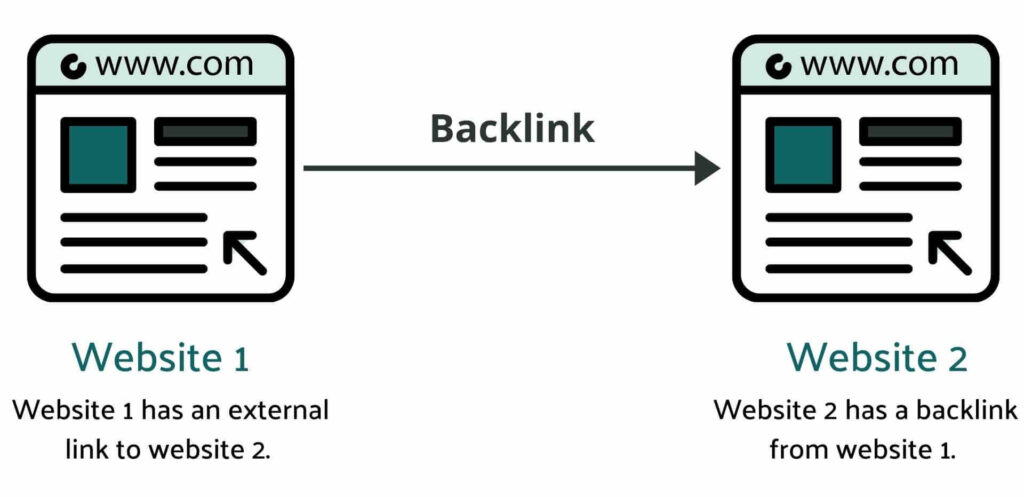
If a website with high domain authority provides a backlink to your webpage, Google can understand that your content is worth ranking high in the search results.
Since Google sees backlinks as votes of confidence, the more backlinks your webpage gets, Google will consider your content as more valuable and rank it high in the search results.
Be noted that the quality of backlinks matters more than the quantity. A few links from a high domain authority website are more valuable than a bunch of links from ordinary websites.
Ok.
On the basic level, there are two types of backlinks.
- Dofollow backlinks – It helps off-page SEO by allowing the transfer of authority (link equity) from the origin to the destination website.
- Nofollow backlinks – It doesn’t allow the transfer of link equity from the origin to the destination website. You can make a link nofollow by adding a rel=”nofollow” attribute.
Having seen the two basic types of backlinks, let’s now see the types of acquiring them.
Natural links
As the name suggests, natural links are those links that come to your website organically.
If you write high-quality content with lots of information, you can gain links naturally.
Built links
Built links are those links that you earn through outreach.
You can reach out to bloggers or publishers, asking them for a backlink.
Ok.
Besides these types, you can also get backlinks by creating them. These backlinks are called created links.
Created links are those links you get by self-submitting your website on directories, forums, etc.
However, be noted that if you incorrectly create the backlinks, you may get penalized by Google.
Here’s an example.
Say that you run a location-specific business. In this case, you can submit your website on a high-quality directory listing and help people find your business.
However, if you submit your website in directory listings (especially the low-quality ones) for getting backlinks, Google may penalize your website.
Ok.
Later in this blog, I’ll explain the link building strategies.
3. Guest posting
Guest posting means that you write and publish content on someone else’s website. It’s a fantastic strategy that you can use to improve your web page’s off-page SEO.
Guest posting has many benefits. It can help you build backlinks to your website, which, in turn, will increase the traffic. Also, it can increase your exposure.
If that website’s audience finds your content beneficial, they can come to your website and check for similar content to gain more information.
Though guest posting has many advantages, it’s beneficial only if you do it correctly.
To find a guest posting opportunity, you can browse Google to come across websites on a niche similar to yours. You can contact that website owner through email to ask for a guest posting opportunity. You can send some of your previous blogs as a sample.
If you get a guest posting opportunity, you can start writing a high-quality blog that will benefit that website’s audience. You can include a backlink to your blog, but it should be in a relevant place.
4. Influencer marketing
In influencer marketing, you approach industry experts and ask them to promote your content.
You can approach influencers on popular social media platforms like Facebook, Instagram, and YouTube for influencer marketing.
The influencer you partner with to promote your content should be on a niche similar to yours. Also, the influencer should have a targeted and engaged audience following.
Be noted that including links in sponsored content violate Google’s Webmaster Guidelines. So, you shouldn’t use influencer marketing to build backlinks to your website.
However, influencer marketing can help increase the exposure of your content, which is an essential part of off-page SEO.
Moreover, influencer marketing can help to increase the traffic to your content.
Ok.
You can partner with an influencer depending on your budget. If you partner with the top influencers in your niche, they will charge a lot of money. But, your content can get a better reach.
If you’re a beginner, you can partner with influencers having an average following. These influencers don’t charge a lot of money; however, the reach of your content will be lower as the following is smaller.
I personally suggest beginners partner with multiple macro-influencers (100K-1M followers). By doing so, you can reach more people without spending a lot of money.
5. Local SEO
Local SEO refers to optimizing a website to increase its visibility in a specific geographic location.
If your business isn’t location-based, I suggest you skip to the next section of this blog, as local SEO isn’t of much use to you.
Below I have explained some off-page SEO factors that influence local SEO.
Google My Business
Google My Business is a tool that lets you optimize your business profile on Google.
When someone searches for your business in Google, here’s how your business profile will appear in the search results if you have set up your Google My Business profile.

Be noted that just adding your business to Google My Business isn’t sufficient. You should make sure to optimize your profile so that it can rank in Google Snack Pack (or local pack).
Google Snack Pack is the box that appears in the search results displaying three local businesses relevant to your search query. It also displays the essential information of those businesses.
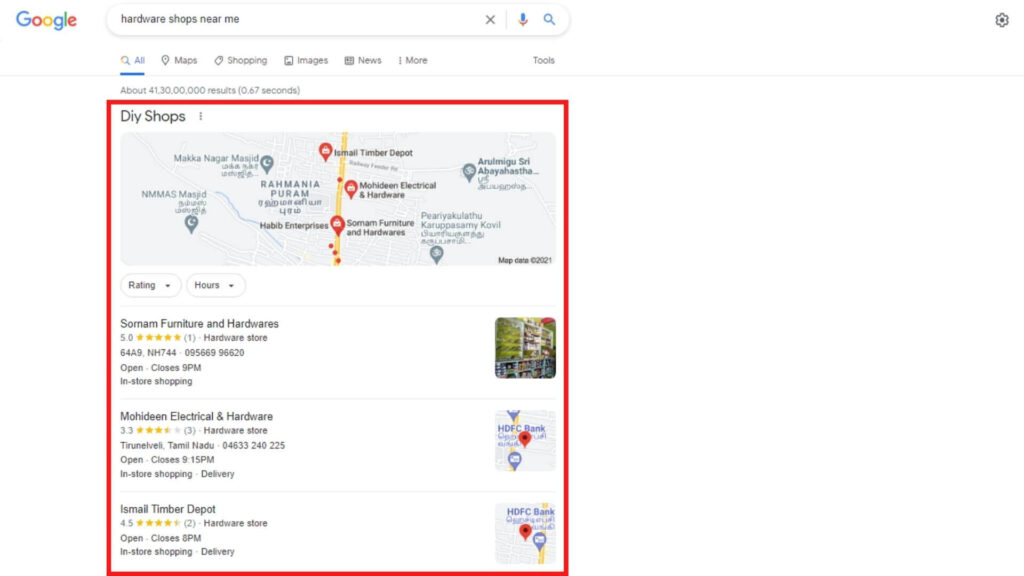
If your business targets a specific geographic location, optimizing your Google My Business profile plays a crucial role in improving your off-page SEO efforts.
Citations
Citations mean that you mention your business name, address, and phone number (NAP) on a third-party website.
If you want your business to rank well for local searches, you should focus on citations. Moreover, according to Moz, citations are one of the top local off-page ranking factors.
Be noted that consistency is essential to succeed with citations. “Consistency” here means that you should have the same name, address, and phone number across all listings.
You can use SEMRush’s Listing Management tool to check your citations and find new citation opportunities.
Reviews
Generally speaking, if you want to build trust among the customers, you should have more positive reviews. The same holds true for local SEO.
If you have many positive and genuine reviews on your Google My Business profile and other third-party websites, you can attract a lot of customers.
Link building strategies
As you would probably know by now, link building is the most important off-page SEO factor.
So, now, let’s discuss the link building strategies.
1. Write high-quality content
Writing high-quality content is the first step of link building.
If you want to get backlinks from websites, you should write high-quality content.
Ok.
If you’re an expert in your niche, you can research and publish original research content.
I understand that performing research isn’t an easy task. It requires a lot of time and effort. But, trust me, it’s worth it.
An original research content can help you gain the attention of bloggers in your niche and build backlinks quickly.
Besides original research content, you can also publish detailed guides to build backlinks quickly.
Writing a detailed guide takes a lot of time. But, since they contain a lot of information on a specific topic, it’s highly beneficial to the readers.
Since detailed guides are beneficial to the readers, they can help you get backlinks from other bloggers — provided your guide is of good quality.
Ok.
You can also add attractive infographics to your blog to get backlinks.
As you know, adding an image to a blog can make it look more attractive. Adding infographics will make the blog even more attractive. Moreover, it’ll make the blog more engaging to read.
If a blogger wants to add an infographic to his blog, he will look for it on the web. If he finds a good infographic, he will include it in his blog and provide a backlink to the owner.
2. Broken link building
Broken link building refers to building backlinks by finding and replacing broken links on a relevant third-party website.
Broken link building involves three main steps. Below I have explained them in detail.
Step #1: Find broken links
The first step in broken link building is to find broken links from the website you want to get backlinks.
You can use tools like the Check My Links Google Chrome extension to find broken links on a webpage.
Once you install Check My Links, you’ll notice a small icon in the top right corner of your Chrome browser.

Click on that icon to check the broken links on the page you’re on. If the tool detects a broken link, it’ll highlight it in red color.
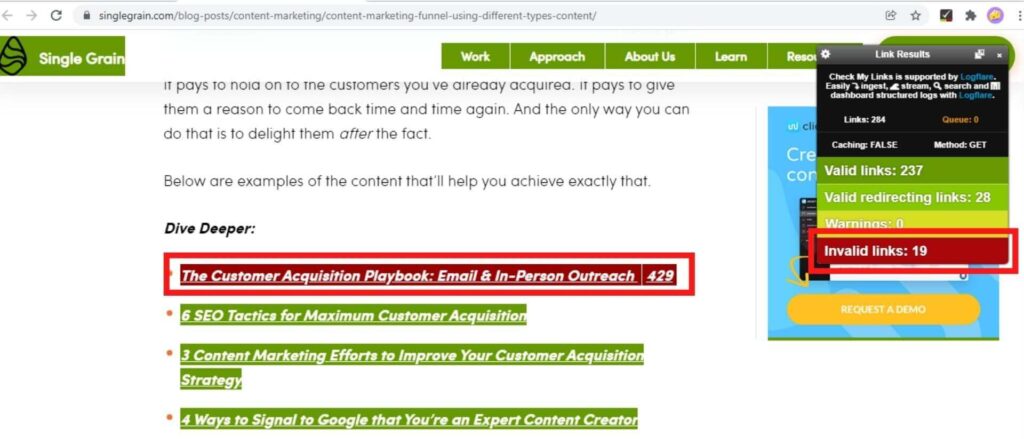
Ok.
Besides Check My Links, you can also use SEMRush’s Backlink Analytics tool to find the broken links. This method is easier because you don’t have to check each page individually for broken links.
The following are the steps to find broken links using the SEMRush Backlink Analytics tool.
- Choose a website that you want to check for broken links. Enter its URL in the tool and click “Search”.

- Switch to the “Indexed Pages” tab.
- Click on the “Broken Pages” checkbox to see only the broken pages.
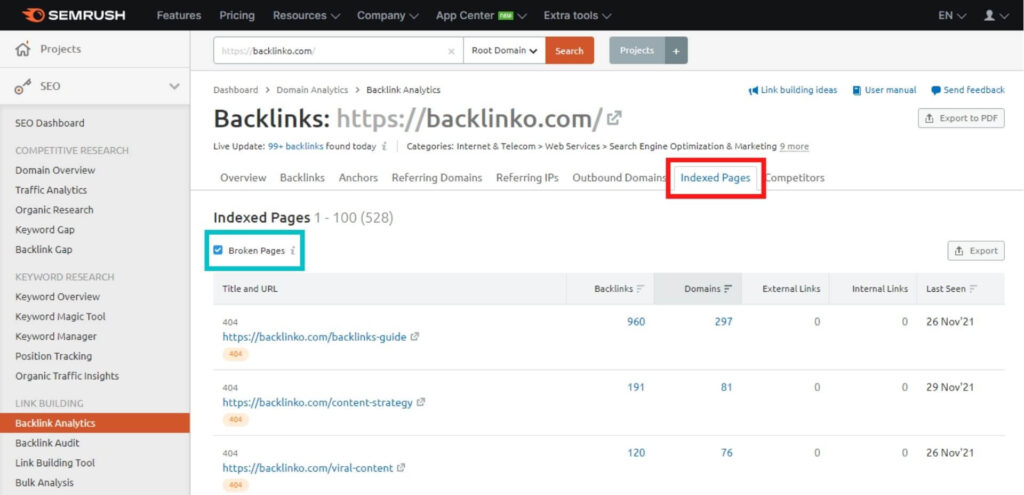
Step #2: Create a similar content
Once you find the broken link, check whether you have a blog on a similar topic to replace the broken link.
If you don’t have a blog to replace the broken link, you can create a blog on a similar topic.
Step #3: Request the website owner to replace the broken link with your blog
Now that you have created a blog to replace the broken link, you can approach the website owner through email and inform him about the broken link on his blog.
Next, you can request whether he can replace the broken link with your content. When requesting, you should explain how your content will benefit him.
Here’s an example of how you should send an email for broken link building.
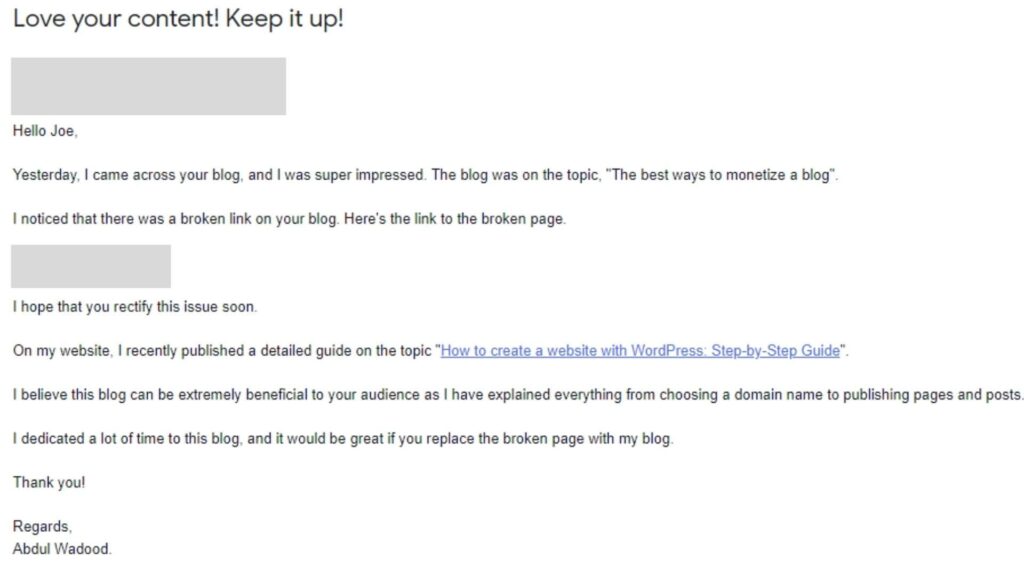
Bonus tip: Get more backlinks
Do you want to get more backlinks to the blog you created for broken link building? Who doesn’t?
You can go to the SEMRush Backlink Analytics tool. Next, paste the URL of the broken page into the tool and click “Search”.

Switch to the “Backlinks” tab. Here, you can get a list of all the websites that have provided backlinks to the broken page you entered.
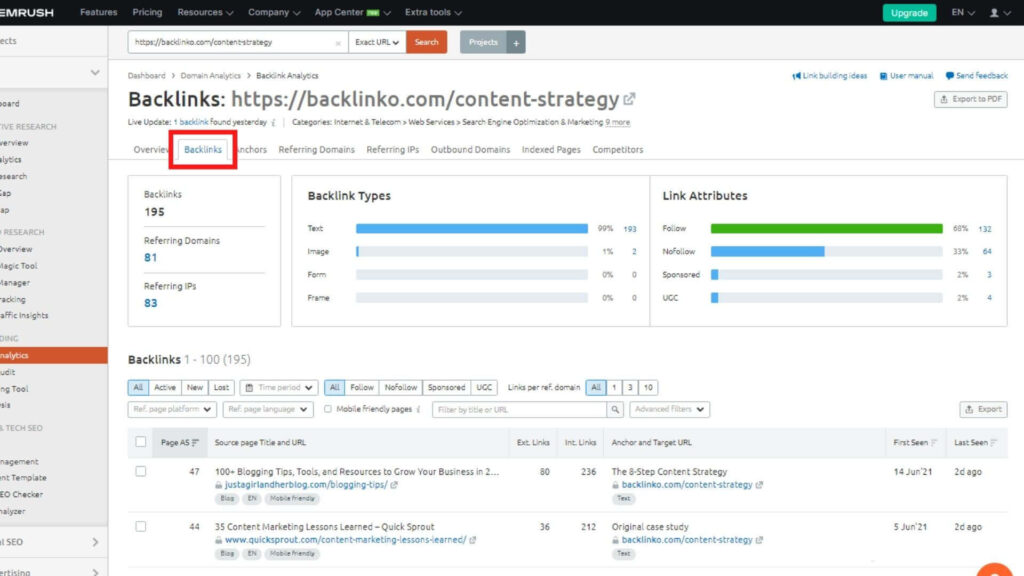
You can approach those website owners and request them to replace the broken link with your blog. Be noted that you should only aim to get backlinks from good websites.
If you feel that a website is low-quality, it’s better that you don’t approach them for a backlink.
3. Email outreach
In this method, you reach out to bloggers and gently ask them to provide a backlink to your blog. You can reach out to bloggers through email.
When you approach bloggers for backlinks, you should explain how linking your blog will benefit their readers.
Ok.
The email outreach strategy will work pretty well if your website is popular and if your content is unique. However, if you’re a beginner, I suggest using broken link building to acquire backlinks to your blog.
In broken link building, since you provide value to bloggers by letting them know dead links on their webpage, there’s a better chance for them to provide a backlink in return.
4. Content syndication
Content syndication means that you republish your content on other websites to reach more people.
Content syndication is a win-win strategy as it benefits both yourself and the website where your content is shared.
You, as the content creator, can get backlinks to your content. Moreover, your content can get better exposure.
The third-party website is benefitted by getting new content.
Ok.
Before you syndicate your content, you should find a relevant partner. You can do a simple Google search or use the backlink checker of SEO tools like SEMRush or Ubersuggest to find a partner for content syndication.
In Google, you can use phrases likes “republished from”, “originally appeared”, “originally published in”, etc., to find content syndication partners. You can add “inurl:[specificniche]” to narrow your search.
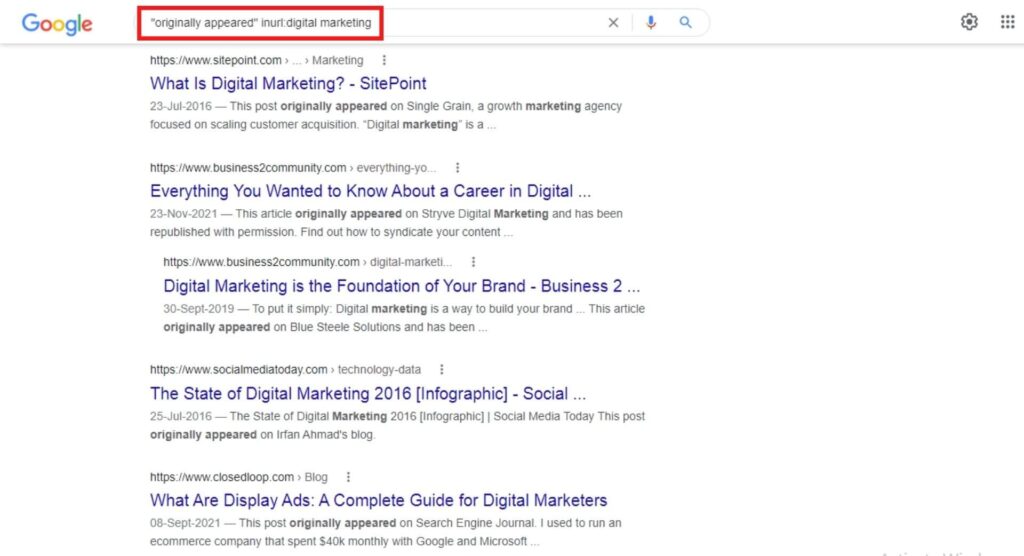
You can analyze the websites appearing in the search results and reach out to them for content syndication partnership. Since they allowed the publishing of syndicate content on their website, they can agree to partner with you for content syndication.
Ok.
If you’re using SEO tools like SEMRush, you can analyze a website’s backlinks by entering its URL to find content syndication opportunities.

You can add the “Anchor” filter with text like “originally published” to narrow down the results.

If you want to get the best results from content syndication, you should partner with a website on a niche similar to yours. Also, it’s better if you choose to partner with a high domain authority website as backlinks from bigger websites are more valuable.
Alright.
When you partner with a website for content syndication, you should ask the website owner to provide a clear attribution and backlink to your blog.
Moreover, you should ask your partner to add the canonical link to the republished blog. This is to make sure that Google knows the original source of the content.
If Google knows the original source of the content, your blog won’t get outranked in the search results by the syndicated content.
5. Write content on article submission sites
Publishing content on article submission sites is a great way to build backlinks and increase traffic to your blogs.
There are lots of article submission sites out there. However, if you want to get the best results, you should publish your blog on sites providing dofollow backlinks.
The following are some of the best article submission sites that provide dofollow backlinks:
- Medium
- Google Sites
- Wattpad
- HubPages
- Tumblr
You can sign up for these websites and start publishing high-quality content. In the content you write, include backlinks to your blog; however, make sure that it’s in a relevant place.
6. Replicate your competitor’s link building strategy
You can replicate your competitor’s link building strategy to build backlinks to your website.
In other words, you can try to get backlinks from websites that already provided a link to your competitor’s website.
The following are the steps involved in this method.
Step #1: Find your competitors
You can search for the phrase you want to rank for in Google. You can consider the websites appearing on the first page of the search results as your competitors.
For example, say that I want to rank for the keyword “what is an em dash”. In this case, I can consider the following websites as my competitors.

Step #2: Find the websites that have provided a backlink to your competitor’s webpage
You can use SEMRush’s Backlink Analytics tool to find the websites that have provided a backlink to your competitor’s webpage.
For instance, I’ll enter an URL in the tool.
I can switch to the “Backlinks” tab to view the websites providing a backlink to the URL I have entered.
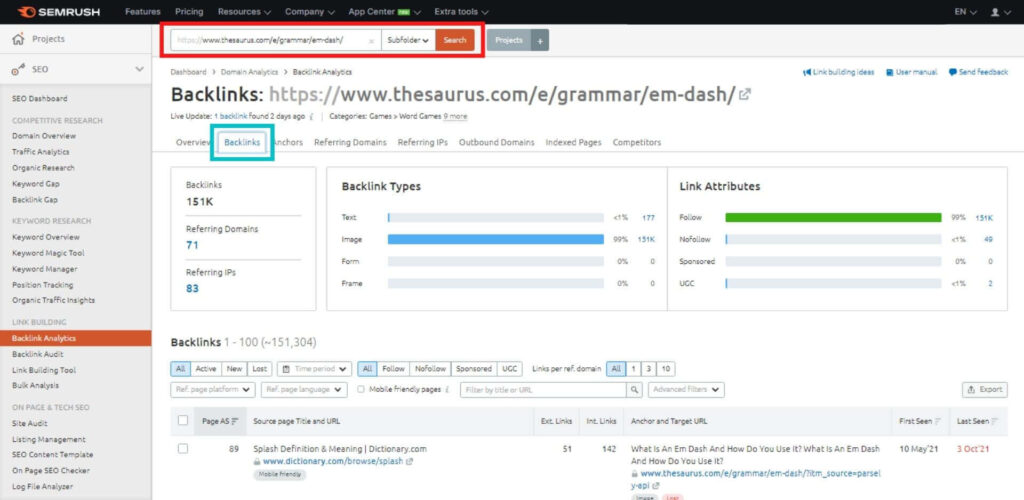
You can note down the URL of the top five linking websites. If needed, you may also note down the URLs of more websites.
Using the same procedure, you can find websites that have provided backlinks to other competitors.
Step #3: Replicate your competitor’s technique
Now that you have made a list of websites providing backlinks to your competitors, you can open each URL and check how your competitors got the backlink.
You can replicate the same method your competitor used to get the backlink. Rinse and repeat this process for all the URLs you have with you.
Conclusion
Off-page SEO plays a significant role in making your website rank high on search results.
Link building is the major off-page SEO factor. However, besides link building, other factors also influence off-page SEO.
You can utilize the strategies explained in this blog to improve your website’s off-page SEO.
If you have any doubts, let me know in the comment section below.

2. Social media marketing
Social media marketing is one of the best ways to increase the exposure of your business.
Nowadays, as you know, a lot of people use social media. Businesses can utilize this opportunity to increase their brand awareness and build a strong audience base.
If you’re not utilizing social media yet, trust me, you’re leaving behind a lot of money on the table.
Social media doesn’t directly influence the ranking of your website in the search results. But, it helps you gain exposure in front of your potential customers.
If your business is not on popular social media platforms, I urge you to start a business page and publish beneficial content related to your niche. When you publish content consistently, your presence will eventually increase.
You can also use social media to increase the traffic to your blogs.
If you want to promote your blog through social media, you can create a post related to your blog’s topic and add a link to your blog in the caption as a source for more information. If people are interested to learn more about that topic, they will visit your blog.
Here, I would like to note that the link you place in the caption of your social media posts will be nofollow links. This is the case with most social media platforms.
Ok.
Lastly, I would like to let you know that social signals (social shares) don’t directly influence the ranking of your webpage in the search results. But, it does so indirectly.
If your content gets shared a lot, many people will view it. Moreover, your content can gain the attention of bloggers. If other bloggers find your blog valuable, they may provide you with a backlink, which will help off-page SEO.
Bonus tip: If you have a service-based business, you can utilize social media networks like Facebook as a customer service platform. You can provide it as an additional option for customers to reach out to you.